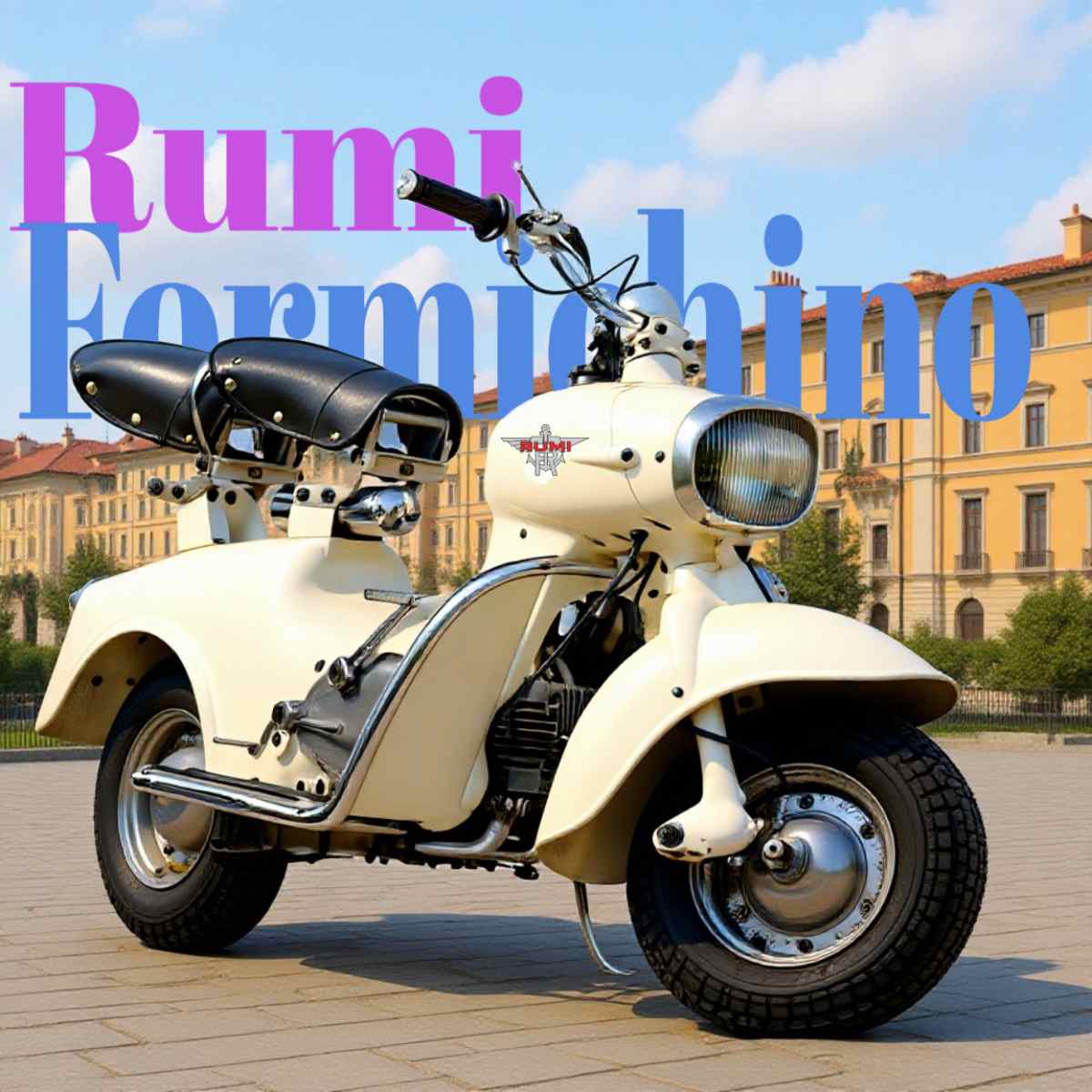- Posted on
- • History
Rumi Formichino – The Italian Aluminium "Little Ant" Worth £10k Today
- Author
-
-

- User
- Torque
- Posts by this author
- Posts by this author
-

Rumi Formichino – the Italian aluminium “little ant” that collectors now chase for £10k a pop
Reading time: 4 min | Word count: ≈ 810
1. 1954: a sculptor, a clay lump and the birth of the "Little Ant"
Donnino Rumi was heir to a Lombardy textile empire but preferred bronze sculptures to shuttle looms. In 1954 he modelled a full-size clay buck around a 125 cc engine on his workshop floor, sculpting smooth, ant-like curves that would become the Formichino ("little ant").
The scooter was reportedly finalised by engineer Ing. Salvatti, but every panel bore the hand-finished signature of Rumi's art-school background – no two early tanks are absolutely identical.
2. Cast-aluminium monocoque – motorcycle meets modern art
- Front and rear body castings bolt directly to the engine, forming a stressed-member monocoque – 1950s F1 technology on two wheels.
- Chain-case, swinging-arm and silencer box are also sand-cast aluminium, giving a dry weight of just 89 kg – 15 kg lighter than a Vespa of the same year.
- 8-inch wheels (1954-57) were later upsized to 10-inch (1958-on) for better ground clearance and stability.
- Panels are welded, filed and polished, then chrome-plated on early "Junior Gentleman" models – a finish that costs £2,000 to replicate today.
3. Engine & specs – 125 cc rotary-disc two-stroke that revved to 8,000 rpm
| Spec | Figure |
|---|---|
| Engine | 123 cc, air-cooled, rotary-disc-valve, 2-stroke |
| Bore × stroke | 55 × 52 mm |
| Compression | 8.2 : 1 (9.5 : 1 on Tipo Sport) |
| Carb | 19 mm Dell'Orto (22 mm on Sport) |
| Power | 7 bhp @ 6,500 rpm (9 bhp Sport) |
| Gearbox | 4-speed, twist-grip shift (RHD UK bikes kept twist-grip) |
| Brakes | 150 mm chrome-plated aluminium drums F/R |
| Tank | 11 L under front panel |
| Top speed | 110 km/h (68 mph) de-restricted Sport |
Rotary-disc inlet gives crisp throttle and 8,000 rpm capability – unheard-of for 1950s scooters.
4. Bol d'Or glory – 24-hour wins that turned a city scooter into a endurance hero
- 1957, 1958, 1960 – factory "Tipo Sport" Formichinos won the Bol d'Or 24-hour at Montlhéry, averaging 98 km/h including pit-stops.
- Victory mods: 22 mm carbs, higher compression, oil-injection deleted (ran 20:1 pre-mix), additional headlights and quick-fill tank cap.
- To celebrate, Rumi released a gold-painted, twin-carb "Bol d'Or" limited edition – < 300 units, most sold in France.
- Winning bike #16 is displayed at Museo Nicolis, Verona, still wearing 24-hour grime under clear-coat.
5. UK cult following – dropped bars, twin carbs and the Ton-up boys
Grey-imports reached London scooter dealers in 1956. Mods loved the chrome tank, dropped bars and 70 mph potential – perfect for the A10 café-dash.
UK-spec bikes received:
- Twin 18 mm Dell'Orto carbs (French market stayed single 22 mm).
- Chrome-plated cylinder with external fins – better heat rejection in stop-start London traffic.
- Lucas 6 V electrics and Smiths speedo – period reviews praised the 90 mph clock (optimistic by 20%, but looked cool).
6. Why so rare – liquidation, aluminium scrap and the missing jigs
- 1961: Rumi went into liquidation; Donnino returned to sculpture and sold factory contents by weight – aluminium castings fetched scrap price.
- No jigs survived; every panel today is either original or hand-beaten from patterns – hence £1,500 for a perfect front fender.
- Total production: ≈ 12,000 units across all variants; survivors < 1,000 worldwide, with < 300 outside Italy.
7. Auction radar 2025 – £3k barn-find to £10k concours in five years
- 2022 H&H Classics: 1956 matching-numbers, 50-year ownership, €9,200 (£8,100).
- 2023 Bonhams: 1957 Bol d'Or edition, gold paint, 22 mm carbs, €11,800 (£10,200) – new price record for a Formichino.
- 2024 Manor Park: 1960 Sport, 3,000 km odometer, £3,450 – budget entry for a restorer.
Ten-year ROI: average 12% per annum, outpacing classic Vespas and most 1950s British bikes.
8. 60-second buyer checklist – numbers, cracks, carbs, colours
- VIN plate on RHS of headset – should read "MB125" + sequential number; no plate = 30% price drop.
- Chrome cylinder: pitting acceptable, flaking fins mean re-sleeve (£400).
- Crack test castings: look for hair-lines around headset weld and chain-case mouth – common stress points.
- Carbs: UK twin 18 mm is desirable; single 22 mm is French market – not inferior, just different.
- Colour: Italian models – metallic blue or ivory; UK – chrome tank + black body; Bol d'Or – gold with black flashes – verify with factory list before paying premium.
9. Quick-fire FAQ – oil-in-fuel, spares, Sport vs Standard, French market
Q1. Oil ratio for daily running?
25:1 with modern semi-synthetic; castor 20:1 for show-day smell – expect plug chops every 150 km.
Q2. Where do I find a chrome-plated cylinder today?
Moto Rumi IG Club (Germany) – €450 exchange; alternative is Nikasil re-plate – €300 but loses period chrome shine.
Q3. Sport vs Standard – external clues?
Sport has 22 mm carb, higher compression dome, "Tipo Sport" badge on leg-shield, no centre-stand (weight saving).
Q4. Are French-market single-carb bikes worth less?
About 10% less; performance near-identical, but collectors prefer twin-carb "British" spec for visual drama.
Q5. Do I need lead additive in the fuel?
No – chrome-plated aluminium bore is hard enough; lead substitute won't adhere anyway – use 98 RON + octane booster if you plan extended high rpm.
Bottom Line
The Rumi Formichino is part sculpture, part racer, part city scooter – a hand-crafted aluminium ant that won 24-hour endurance races and still fetches ten-grand at auction.
With fewer than 1,000 survivors, no production jigs, and chrome tanks that out-shine 1950s Cadillacs, the Formichino isn't just Italy's rarest collectible scooter – it's rolling Mid-Century Modern art that you can ride to the café at 70 mph.
If you find a matching-numbers, chrome-cylinder example, buy it, polish it, ride it – because antiques this chic rarely come with two-stroke soundtracks.
